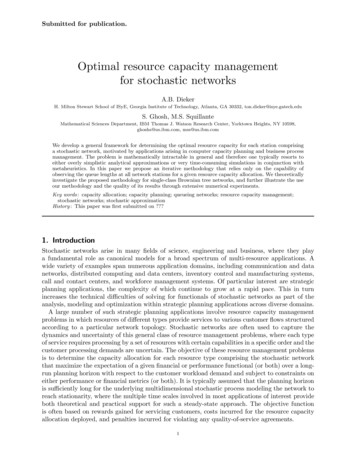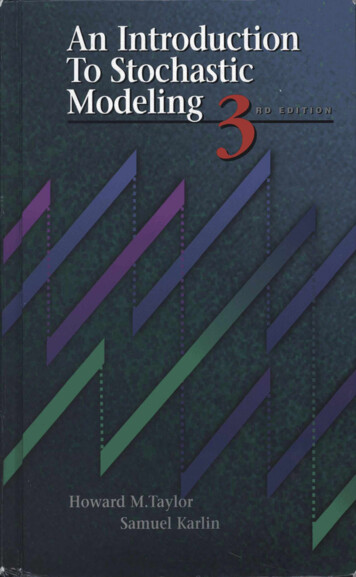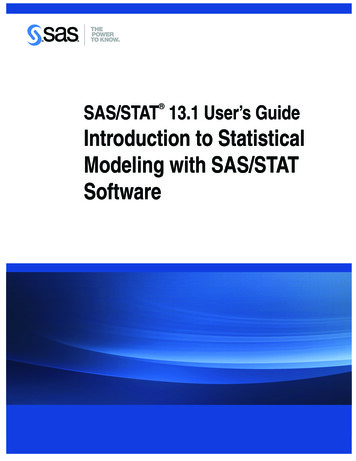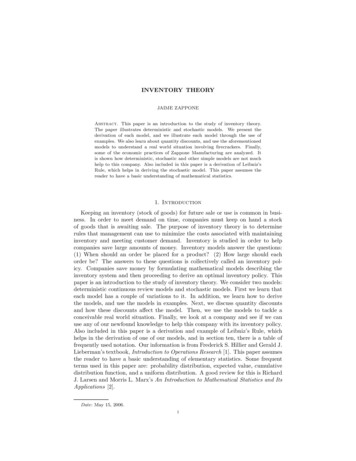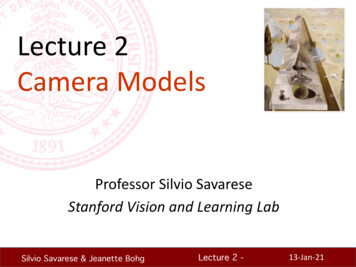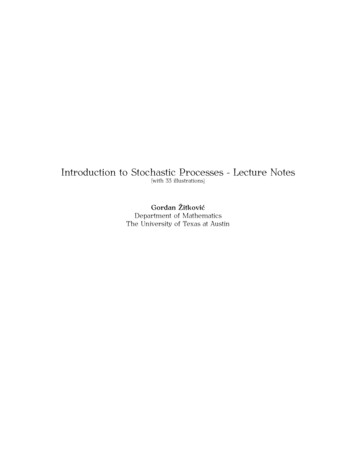
Transcription
Introduction to Stochastic Processes - Lecture Notes(with 33 illustrations)Gordan ŽitkovićDepartment of MathematicsThe University of Texas at Austin
Contents1 Probability review1.1 Random variables . . . . . . . .1.2 Countable sets . . . . . . . . . . .1.3 Discrete random variables . . .1.4 Expectation . . . . . . . . . . . .1.5 Events and probability . . . . . .1.6 Dependence and independence1.7 Conditional probability . . . . .1.8 Examples . . . . . . . . . . . . . .2 Mathematica in 15 min2.1 Basic Syntax . . . . . . . . . . . . . . . . . .2.2 Numerical Approximation . . . . . . . . .2.3 Expression Manipulation . . . . . . . . . .2.4 Lists and Functions . . . . . . . . . . . . .2.5 Linear Algebra . . . . . . . . . . . . . . . .2.6 Predefined Constants . . . . . . . . . . . .2.7 Calculus . . . . . . . . . . . . . . . . . . . .2.8 Solving Equations . . . . . . . . . . . . . .2.9 Graphics . . . . . . . . . . . . . . . . . . . .2.10 Probability Distributions and Simulation2.11 Help Commands . . . . . . . . . . . . . . .2.12 Common Mistakes . . . . . . . . . . . . . .3 Stochastic Processes3.1 The canonical probability space . . . . .3.2 Constructing the Random Walk . . . . .3.3 Simulation . . . . . . . . . . . . . . . . . . .3.3.1 Random number generation . . .3.3.2 Simulation of Random Variables3.4 Monte Carlo Integration . . . . . . . . . 30334 The Simple Random Walk354.1 Construction . . . . . . . . . . . . . . . . . . . . . . . . . . . . . . . . . . . . . . . . . . . . . . 354.2 The maximum . . . . . . . . . . . . . . . . . . . . . . . . . . . . . . . . . . . . . . . . . . . . 361
CONTENTS5 Generating functions405.1 Definition and first properties . . . . . . . . . . . . . . . . . . . . . . . . . . . . . . . . . . . 405.2 Convolution and moments . . . . . . . . . . . . . . . . . . . . . . . . . . . . . . . . . . . . . 425.3 Random sums and Wald’s identity . . . . . . . . . . . . . . . . . . . . . . . . . . . . . . . . 446 Random walks - advanced methods6.1 Stopping times . . . . . . . . . . . . . . . . . . .6.2 Wald’s identity II . . . . . . . . . . . . . . . . . .6.3 The distribution of the first hitting time T1 .6.3.1 A recursive formula . . . . . . . . . . .6.3.2 Generating-function approach . . . . .6.3.3 Do we actually hit 1 sooner or later?6.3.4 Expected time until we hit 1? . . . . .4848505252535555.5656565758618 Markov Chains8.1 The Markov property . . . . . . . . . . . . . . . . . . . . . . . . . . . . . . . . . . . . . . . .8.2 Examples . . . . . . . . . . . . . . . . . . . . . . . . . . . . . . . . . . . . . . . . . . . . . . . .8.3 Chapman-Kolmogorov relations . . . . . . . . . . . . . . . . . . . . . . . . . . . . . . . . .636364709 The9.19.29.39.49.59.67 Branching processes7.1 A bit of history . . . . . . . . . . . . . . . . .7.2 A mathematical model . . . . . . . . . . . .7.3 Construction and simulation of branching7.4 A generating-function approach . . . . . .7.5 Extinction probability . . . . . . . . . . . . .“Stochastics” packageInstallation . . . . . . . . . . . . . . .Building Chains . . . . . . . . . . . .Getting information about a chainSimulation . . . . . . . . . . . . . . .Plots . . . . . . . . . . . . . . . . . . .Examples . . . . . . . . . . . . . . . .10 Classification of States10.1 The Communication Relation10.2 Classes . . . . . . . . . . . . . .10.3 Transience and recurrence .10.4 Examples . . . . . . . . . . . . . . . . . . . . . . . . .processes. . . . . . . . . . . . .74747475767677.797981838411 More on Transience and recurrence8611.1 A criterion for recurrence . . . . . . . . . . . . . . . . . . . . . . . . . . . . . . . . . . . . . 8611.2 Class properties . . . . . . . . . . . . . . . . . . . . . . . . . . . . . . . . . . . . . . . . . . . 8811.3 A canonical decomposition . . . . . . . . . . . . . . . . . . . . . . . . . . . . . . . . . . . . 89Last Updated: December 24, 20102Intro to Stochastic Processes: Lecture Notes
CONTENTS12 Absorption and reward9212.1 Absorption . . . . . . . . . . . . . . . . . . . . . . . . . . . . . . . . . . . . . . . . . . . . . . . 9212.2 Expected reward . . . . . . . . . . . . . . . . . . . . . . . . . . . . . . . . . . . . . . . . . . . 9513 Stationary and Limiting Distributions9813.1 Stationary and limiting distributions . . . . . . . . . . . . . . . . . . . . . . . . . . . . . . . 9813.2 Limiting distributions . . . . . . . . . . . . . . . . . . . . . . . . . . . . . . . . . . . . . . . . 10414 Solved Problems14.1 Probability review . . . . . . . . . . . . . . . . . . . . . .14.2 Random Walks . . . . . . . . . . . . . . . . . . . . . . . .14.3 Generating functions . . . . . . . . . . . . . . . . . . . .14.4 Random walks - advanced methods . . . . . . . . . . .14.5 Branching processes . . . . . . . . . . . . . . . . . . . .14.6 Markov chains - classification of states . . . . . . . . .14.7 Markov chains - absorption and reward . . . . . . . .14.8 Markov chains - stationary and limiting distributions14.9 Markov chains - various multiple-choice problems .Last Updated: December 24, 20103.107107111114120122133142148156Intro to Stochastic Processes: Lecture Notes
Chapter 1Probability reviewThe probable is what usually happens.—AristotleIt is a truth very certain that when it is not in our power to determine. what istrue we ought to follow what is most probable—Descartes - “Discourse on Method”It is remarkable that a science which began with the consideration of games ofchance should have become the most important object of human knowledge.—Pierre Simon Laplace - “Théorie Analytique des Probabilités, 1812 ”Anyone who considers arithmetic methods of producing random digits is, ofcourse, in a state of sin.—John von Neumann - quote in “Conic Sections” by D. MacHaleI say unto you: a man must have chaos yet within him to be able to give birth toa dancing star: I say unto you: ye have chaos yet within you . . .—Friedrich Nietzsche - “Thus Spake Zarathustra”1.1Random variablesProbability is about random variables. Instead of giving a precise definition, let us just metion thata random variable can be thought of as an uncertain, numerical (i.e., with values in R) quantity.While it is true that we do not know with certainty what value a random variable X will take, weusually know how to compute the probability that its value will be in some some subset of R. Forexample, we might be interested in P[X 7], P[X [2, 3.1]] or P[X {1, 2, 3}]. The collection ofall such probabilities is called the distribution of X. One has to be very careful not to confusethe random variable itself and its distribution. This point is particularly important when severalrandom variables appear at the same time. When two random variables X and Y have the samedistribution, i.e., when P[X A] P[Y A] for any set A, we say that X and Y are equally(d)distributed and write X Y .4
CHAPTER 1. PROBABILITY REVIEW1.2Countable setsAlmost all random variables in this course will take only countably many values, so it is probablya good idea to review breifly what the word countable means. As you might know, the countableinfinity is one of many different infinities we encounter in mathematics. Simply, a set is countableif it has the same number of elements as the set N {1, 2, . . . } of natural numbers. Moreprecisely, we say that a set A is countable if there exists a function f : N A which is bijective(one-to-one and onto). You can think f as the correspondence that “proves” that there exactly asmany elements of A as there are elements of N. Alternatively, you can view f as an orderingof A; it arranges A into a particular order A {a1 , a2 , . . . }, where a1 f (1), a2 f (2), etc.Infinities are funny, however, as the following example showsExample 1.1.1. N itself is countable; just use f (n) n.2. N0 {0, 1, 2, 3, . . . } is countable; use f (n) n 1. You can see here why I think thatinfinities are funny; the set N0 and the set N - which is its proper subset - have the samesize.3. Z {. . . , 2, 1, 0, 1, 2, 3, . . . } is countable; now the function f is a bit more complicated;(2k 1, k 0f (k) 2k,k 0.You could think that Z is more than “twice-as-large” as N, but it is not. It is the same size.4. It gets even weirder. The set N N {(m, n) : m N, n N} of all pairs of naturalnumbers is also countable. I leave it to you to construct the function f .5. A similar argument shows that the set Q of all rational numbers (fractions) is also countable.6. The set [0, 1] of all real numbers between 0 and 1 is not countable; this fact was first provenby Georg Cantor who used a neat trick called the diagonal argument.1.3Discrete random variablesA random variable is said to be discrete if it takes at most countably many values. More precisely,X is said to be discrete if there exists a finite or countable set S R such that P[X S] 1,i.e., if we know with certainty that the only values X can take are those in S. The smallest set Swith that property is called the support of X. If we want to stress that the support correspondsto the random variable X, we write X .Some supports appear more often then the others:1. If X takes only the values 1, 2, 3, . . . , we say that X is N-valued.2. If we allow 0 (in addition to N), so that P[X N0 ] 1, we say that X is N0 -valuedLast Updated: December 24, 20105Intro to Stochastic Processes: Lecture Notes
CHAPTER 1. PROBABILITY REVIEW3. Sometimes, it is convenient to allow discrete random variables to take the value . Thisis mostly the case when we model the waiting time until the first occurence of an eventwhich may or may not ever happen. If it never happens, we will be waiting forever, andthe waiting time will be . In those cases - when S {1, 2, 3, . . . , } N { } we say that the random variable is extended N-valued. The same applies to the case of N0(instead of N), and we talk about the extended N0 -valued random variables. Sometimes theadjective “extended” is left out, and we talk about N0 -valued random variables, even thoughwe allow them to take the value . This sounds more confusing that it actually is.4. Occasionally, we want our random variables to take values which are not necessarily numbers (think about H and T as the possible outcomes of a coin toss, or the suit of a randomlychosen playing card). Is the collection of all possible values (like {H, T } or { , , , }) iscountable, we still call such random variables discrete. We will see more of that when westart talking about Markov chains.Discrete random variables are very nice due to the following fact: in order to be able to computeany conceivable probability involving a discrete random variable X, it is enough to know howto compute the probabilities P[X x], for all x S. Indeed, if we are interested in figuring outhow much P[X B] is, for some set B R (B [3, 6], or B [ 2, )), we simply pick all x Swhich are also in B and sum their probabilities. In mathematical notation, we haveXP[X B] P[X x].x S BFor this reason, the distribution of any discrete random variable X is usually described via atable x1 x2 x3 . . .,X p1 p2 p3 . . .where the top row lists all the elements of S (the support of X) and the bottom row lists theirprobabilities (pi P[X xi ], i N). When the random variable is N-valued (or N0 -valued), thesituation is even simpler because we know what x1 , x2 , . . . are and we identify the distributionof X with the sequence p1 , p2 , . . . (or p0 , p1 , p2 , . . . in the N0 -valued case), which we call theprobability mass function (pmf) of the random variable X. What about the extended N0 -valuedcase? It is as simple because we can compute the probability P[X ], if we know all theprobabilities pi P[X i], i N0 . Indeed, we use the fact thatP[X 0] P[X 1] · · · P[X ] 1,Pso that P[X ] 1 i 1 pi , where pi P[X i]. In other words,Pif you are given aprobability mass function (p0 , p1 , . . . ), you simply need to compute the sum i 1 pi . If it happensto be equal to 1, you can safely conclude that X never takes the value . Otherwise, theprobability of is positive.The random variables for which S {0, 1} are especially useful. They are called indicators.The name comes from the fact that you should think of such variables as signal lights; if X 1an event of interest has happened, and if X 0 it has not happened. In other words, X indicatesthe occurence of an event. The notation we use is quite suggestive; for example, if Y is theoutcome of a coin-toss, and we want to know whether Heads (H) occurred, we writeX 1{Y H} .Last Updated: December 24, 20106Intro to Stochastic Processes: Lecture Notes
CHAPTER 1. PROBABILITY REVIEWExample 1.2. Suppose that two dice are thrown so that Y1 and Y2 are the numbers obtained (bothY1 and Y2 are discrete random variables with S {1, 2, 3, 4, 5, 6}). If we are interested in theprobability the their sum is at least 9, we proceed as follows. We define the random variable Z the sum of Y1 and Y2 - by Z Y1 Y2 . Another random variable, let us call it X, is defined byX 1{Z 9} , i.e.,(1, Z 9,X 0, Z 9.With such a set-up, X signals whether the event of interest has happened, and we can state ouroriginal problem in terms of X : “Compute P[X 1] !”. Can you compute it?1.4ExpectationFor a discrete random variable X with support , we define the expectation E[X] of X byXE[X] xP[X x],x Pas long as the (possibly) infinite sum x xP[X x] absolutely converges. When the sum doesnot converge, or if it converges only conditionally, we say that the expectation of X is not defined.When the random variable in question is N0 -valued, the expression above simplifies toE[X] Xi pi ,i 0where pi P[X i], for i N0 . Unlike in the general case, the absolute convergence of thedefining series can fail in essentially one way, i.e., whenlimn nXipi .i 0In that case, the expectation does not formally exist. We still write E[X] , but really meanthat the defining sum diverges towards infinity.Once we know what the expectation is, we can easily define several more common terms:Definition 1.3. Let X be a discrete random variable. If the expectation E[X] exists, we say that X is integrable. If E[X 2 ] (i.e., if X 2 is integrable), X is called square-integrable. If E[ X m ] , for some m 0, we say that X has a finite m-th moment. If X has a finite m-th moment, the expectation E[ X E[X] m ] exists and we call it the m-thcentral moment.It can be shown that the expectation E possesses the following properties, where X and Yare both assumed to be integrable:Last Updated: December 24, 20107Intro to Stochastic Processes: Lecture Notes
CHAPTER 1. PROBABILITY REVIEW1. E[αX βY ] αE[X] βE[Y ], for α, β R (linearity of expectation).2. E[X] E[Y ] if P[X Y ] 1 (monotonicity of expectation).Definition 1.4. Let X be a square-integrable random variable. We define the variance Var[X]byVar[X] E[(X m)2 ], where m E[X].pThe square-root Var[X] is called the standard deviation of X.Remark 1.5. Each square-integrable random variable is automatically integrable. Also, if the m-thmoment exists, then all lower moments also exist.We still need to define what happens with random variables that take the value , but thatis very easy. We stipulate that E[X] does not exist, (i.e., E[X] ) as long as P[X ] 0.Simply put, the expectation of a random variable is infinite if there is a positive chance (no matterhow small) that it will take the value .1.5Events and probabilityProbability is usually first explained in terms of the sample space or probability space (whichwe denote by Ω in these notes) and various subsets of Ω which are called events1 Events typicallycontain all elementary events, i.e., elements of the probability space, usually denoted by ω. Forexample, if we are interested in the likelihood of getting an odd number as a sum of outcomesof two dice throws, we build a probability spaceΩ {(1, 1), (1, 2), . . . , (6, 1), (2, 1), (2, 2), . . . , (2, 6), . . . , (6, 1), (6, 2), . . . , (6, 6)}and define the event A which contains of all pairs (k, l) Ω such that k l is an odd number, i.e.,A {(1, 2), (1, 4), (1, 6), (2, 1), (2, 3), . . . , (6, 1), (6, 3), (6, 5)}.One can think of events as very simple random variables. Indeed, if, for an event A, we definethe random variable 1A by(1, A happened,1A 0, A did not happen,we get the indicator random variable mentioned above. Conversely, for any indicator randomvariable X, we define the indicated event A as the set of all elementary events at which X takesthe value 1.What does all this have to do with probability? The analogy goes one step further. If we applythe notion of expectation to the indicator random variable X 1A , we get the probability of A:E[1A ] P[A].Indeed, 1A takes the value 1 on A, and the value 0 on the complement Ac Ω \ A. Therefore,E[1A ] 1 P[A] 0 P[Ac ] P[A].1When Ω is infinite, not all of its subsets can be considered events, due to very strange technical reasons. We willdisregard that fact for the rest of the course. If you feel curious as to why that is the case, google Banach-Tarskiparadox, and try to find a connection.Last Updated: December 24, 20108Intro to Stochastic Processes: Lecture Notes
CHAPTER 1. PROBABILITY REVIEW1.6Dependence and independenceOne of the main differences between random variables and (deterministic or non-random) quantities is that in the former case the whole is more than the sum of its parts. What do I mean bythat? When two random variables, say X and Y , are considered in the same setting, you mustspecify more than just their distributions, if you want to compute probabilities that involve bothof them. Here are two examples.1. We throw two dice, and denote the outcome on the first one by X and the second one byY.2. We throw two dice, and denote the outcome of the first one by X, set Y 6 X and forgetabout the second die.In both cases, both X and Y have the same distributionX, Y 123456161616161616!The pairs (X, Y ) are, however, very different in the two examples. In the first one, if the value ofX is revealed, it will not affect our view of the value of Y . Indeed, the dice are not “connected” inany way (they are independent in the language of probability). In the second case, the knowledgeof X allows us to say what Y is without any doubt - it is 6 X.This example shows that when more than one random variable is considered, one needs toobtain external information about their relationship - not everything can be deduced only bylooking at their distributions (pmfs, or . . . ).One of the most common forms of relationship two random variables can have is the one ofexample (1) above, i.e., no relationship at all. More formally, we say that two (discrete) randomvariables X and Y are independent ifP[X x and Y y] P[X x]P[Y y],for all x and y in the respective supports X and Y of X and Y . The same concept can be appliedto events, and we say that two events A and B are independent ifP[A B] P[A]P[B].The notion of independence is central to probability theory (and this course) because it is relativelyeasy to spot in real life. If there is no physical mechanism that ties two events (like the two dicewe throw), we are inclined to declare them independent2 . One of the most important tasksin probabilistic modelling is the identification of the (small number of) independent randomvariables which serve as building blocks for a big complex system. You will see many examplesof that as we proceed through the course.2Actually, true independence does not exist in reality, save, perhaps a few quantum-theoretic phenomena. Even withapparently independent random variables, dependence can sneak in the most sly of ways. Here is a funny example:a recent survey has found a large correlation between the sale of diapers and the sale of six-packs of beer acrossmany Walmart stores throughout the country. At first these two appear independent, but I am sure you can come upwith many an amusing story why they should, actually, be quite dependent.Last Updated: December 24, 20109Intro to Stochastic Processes: Lecture Notes
CHAPTER 1. PROBABILITY REVIEW1.7Conditional probabilityWhen two random variables are not independent, we still want to know how the knowledge ofthe exact value of one of the affects our guesses about the value of the other. That is what theconditional probability is for. We start with the definition, and we state it for events first: for twoevents A, B such that P[B] 0, the conditional probability P[A B] of A given B is defined as:P[A B] P[A B].P[B]The conditional probability is not defined when P[B] 0 (otherwise, we would be computing- why?). Every statement in the sequel which involves conditional probability will be assumedto hold only when P[B] 0, without explicit mention.The conditional probability calculations often use one of the following two formulas. Bothof them use the familiar concept of partition. If you forgot what it is, here is a definition: acollection A1 , A2 , . . . , An of events is called a partition of Ω if a) A1 A2 . . . An Ω and b)Ai Aj for all pairs i, j 1, . . . , n with i 6 j. So, let A1 , . . . , An be a partition of Ω, and letB be an event.001. The Law of Total Probability.P[B] nXP[B Ai ]P[Ai ].i 12. Bayes formula. For k 1, . . . , n, we haveP[B Ak ]P[Ak ]P[Ak B] Pn.i 1 P[B Ai ]P[Ai ]Even though the formulas above are stated for finite partitions, they remain true when the numberof Ak ’s is countably infinite. The finite sums have to be replaced by infinite series, however.Random variables can be substituted for events in the definition of conditional probability asfollows: for two random variables X and Y , the conditional probabilty that X x, given Y y(with x and y in respective supports X and Y ) is given byP[X x Y y] P[X x and Y y].P[Y y]The formula above produces a different probability distribution for each y. This is called theconditional distribution of X, given Y y. We give a simple example to illustrate this concept.Let X be the number of heads obtained when two coins are thrown, and let Y be the indicatorof the event that the second coin shows heads. The distribution of X is Binomial:!012X 1,11424or, in the more compact notation which we use when the support is clear from the contextX ( 14 , 12 , 14 ). The random variable Y has the Bernoulli distribution Y ( 21 , 12 ). What happensLast Updated: December 24, 201010Intro to Stochastic Processes: Lecture Notes
CHAPTER 1. PROBABILITY REVIEWto the distribution of X, when we are told that Y 0, i.e., that the second coin shows heads. Inthat case we have P[X 0,Y 0]P[ the pattern is TT ]1 1/4x 0 P[Y 0] P[Y 0]1/2 2 , 0]is HT ]1/4P[X x Y 0] P[X 1,Y P[ the pattern 1/2 12 ,x 1P[Y 0]P[Y 0] P[X 2,Y 0]P[ well, there is no such pattern ]0 1/2 0 , x 2P[Y 0]P[Y 0]Thus, the conditional distribution of X, given Y 0, is ( 21 , 12 , 0). A similar calculation can be usedto get the conditional distribution of X, but now given that Y 1, is (0, 12 , 21 ). The moral of thestory is that the additional information contained in Y can alter our views about the unknownvalue of X using the concept of conditional probability. One final remark about the relationshipbetween independence and conditional probability: suppose that the random variables X and Yare independent. Then the knowledge of Y should not affect how we think about X; indeed, thenP[X x Y y] P[X x, Y y]P[X x]P[Y y] P[X x].P[Y y]P[Y y]The conditional distribution does not depend on y, and coincides with the unconditional one.The notion of independence for two random variables can easily be generalized to largercollectionsDefinition 1.6. Random variables X1 , X2 , . . . , Xn are said to be independent ifP[X1 x1 , X2 x2 , . . . Xn xn ] P[X1 x1 ]P[X2 x2 ] . . . P[Xn xn ]for all x1 , x2 , . . . , xn .An infinite collection of random variables is said to be independent if all of its finite subcollections are independent.Independence is often used in the following way:Proposition 1.7. Let X1 , . . . , Xn be independent random variables. Then1. g1 (X1 ), . . . , gn (Xn ) are also independent for (practically) all functions g1 , . . . , gn ,2. if X1 , . . . , Xn are integrable then the product X1 . . . Xn is integrable andE[X1 . . . Xn ] E[X1 ] . . . E[Xn ], and3. if X1 , . . . , Xn are square-integrable, thenVar[X1 · · · Xn ] Var[X1 ] · · · Var[Xn ].EquivalentlyCov[Xi , Xj ] E[(X1 E[X1 ])(X2 E[X2 ])] 0,for all i 6 j {1, 2, . . . , n}.Remark 1.8. The last statement says that independent random variables are uncorrelated. Theconverse is not true. There are uncorrelated random variables which are not independent.Last Updated: December 24, 201011Intro to Stochastic Processes: Lecture Notes
CHAPTER 1. PROBABILITY REVIEWWhen several random variables (X1 , X2 , . . . Xn ) are considered in the same setting, we often group them together into a random vector. The distribution of the random vector X (X1 , . . . , Xn ) is the collection of all probabilities of the formP[X1 x1 , X2 x2 , . . . , Xn xn ],when x1 , x2 , . . . , xn range through all numbers in the appropriate supports. Unlike in the caseof a single random variable, writing down the distributions of random vectors in tables is a bitmore difficult. In the two-dimensional case, one would need an entire matrix, and in the higherdimensions some sort of a hologram would be the only hope.The distributions of the components X1 , . . . , Xn of the random vector X are called themarginal distributions of the random variables X1 , . . . , Xn . When we want to stress the fact thatthe random variables X1 , . . . , Xn are a part of the same random vector, we call the distributionof X the joint distribution of X1 , . . . , Xn . It is important to note that, unless random variablesX1 , . . . , Xn are a priori known to be independent, the joint distribution holds more informationabout X than all marginal distributions together.1.8ExamplesHere is a short list of some of the most important discrete random variables. You will learn aboutgenerating functions soon.Example 1.9.Bernoulli. Success (1) of failure (0) with probability p (if success is encoded by 1, failure by 1 and p 12 , we call it the coin toss).0.70.60.50.40.30.20.10.0-0.50.00.5Last Updated: December 24, 20101.0.parameters : p (0, 1) (q 1 p).notation : b(p).support : {0, 1}.pmf : p0 p and p1 q 1 p.generating function : ps q.mean : p .standard deviation :pq.figure :the mass function a Bernoulli distribution with p 1/3.Binomial. The number of successes in n repeti-12Intro to Stochastic Processes: Lecture Notes
CHAPTER 1. PROBABILITY REVIEWtions of a Bernoulli trial with success arameters : n N, p (0, 1) (q 1 p).notation : b(n, p).support : {0, 1, . . . , n}.pmf : pk nk pk q n k , k 0, . . . , n.generating function : (ps q)n.mean : np .standard deviation :npq.figure :mass functions of three binomial distributions with n 50 and p 0.05 (blue), p 0.5(purple) and p 0.8 (yellow).Poisson. The number of spelling mistakes one makes while typing a single page.0.40.30.20.10510152025.parameters : λ 0.notation : p(n, p).support : N0k.pmf : pk e λ λk! , k N0.generating function : eλ(s 1).mean : λ .standard deviation :λ.figure : mass functions of two Poisson distributions with parameters λ 0.9 (blue) and λ 10(purple).Geometric. The number of repetitions of a Bernoulli trial with parameter p until the firstsuccess.0.30.parameters : p (0, 1), q 1 p.notation: g(p)0.25.support : N00.20.pmf : pk pq k 1 , k N0p.generating function : 1 qs0.15.mean : pq 0.100.050510152025Last Updated: December 24, 201030q.standard deviation : p.figure : mass functions of two Geometric distributions with parameters p 0.1 (blue) and p 0.4(purple).13Intro to Stochastic Processes: Lecture Notes
CHAPTER 1. PROBABILITY REVIEWNegative Binomial. The number of failures it takes to obtain r successes in repeated independent Bernoulli trials with success probability p.parameters : r N, p (0, 1) (q 1 p).notation : g(n, p).support : N0 r k N0.pmf : pk
Introduction to Stochastic Processes - Lecture Notes (with 33 illustrations) Gordan Žitković De


